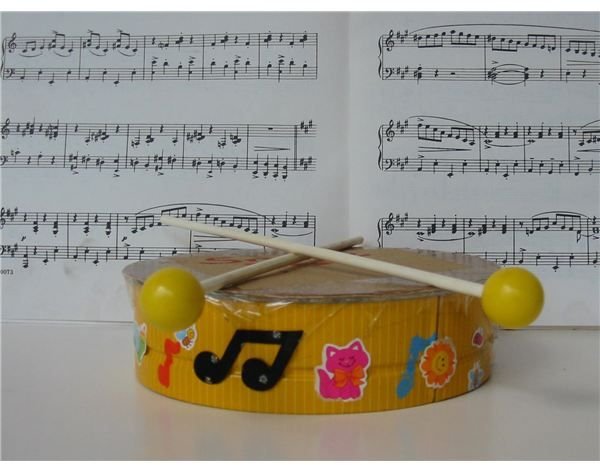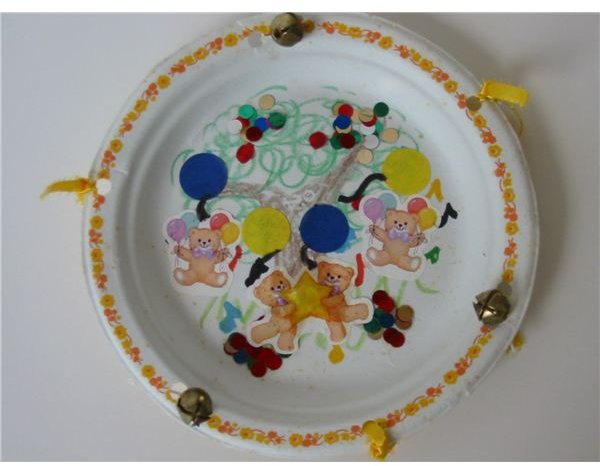Preschool Music Games to Play with Songs and Rhythm Instruments
Bring out a collection of musical instruments for the children to experiement with. This could include kazoos, tamerines, shakers, drums, rhythm sticks, whistles, etc. Discuss the possible uses for each and every instrument you use or make. Encourage a few moments of free experimentation, then invite the children to try to use their instruments to add rhythmic sounds to songs or chants. Introduce games that use the instruments, such as walking quickly or slowly to a drum beat. A second instrument may be introduced to encourage the children to compare the similarities and differences between the two. Finally, gather the children and the instruments together to form a classroom band. Through these preschool music lesson plans, children will develop auditory awareness, along with eye/hand coordination and reinforcing fine and gross motor skills. Below are a few activities to try.
Choosing the Songs
Play in the Band (Tune: “Deck the Halls”)
We are all musicians now,
Come listen to our song and play along.
We will play our instruments,
Just listen to each one, it’s lots of fun.
First we’ll play the tambourines_,_
Rattle, tap, rattle, tap,
Tap, tap, tap.
Let’s all play together now (finish song with all the instruments playing in time).
________________
Use Your Instrument Today (Tune: “Twinkle, Twinkle Little Star”)
Let’s all play our bells today,
To help you sing and dance this way.
Jingle, jingle, ring, ring, ring,
Keep the rhythm with a shake and ring.
So, let’s all play our bells today,
To help you sing and dance this way.
______________

Await the Sound (Tune: " The Farmer in the Dell")
The cymbals go crash, crash,
The cymbals go crash, crash,
At the end of a round, await the sound,
The cymbals go crash, crash.
Other Verses:
The drums go boom, boom…
The sandpaper blocks go swish, swish…
The bells go ding, ding…
During your preschool music lessons substitute the names of other instruments in each song above and describe those instrument sounds.
Games to Use With Musical Instruments
Instrumental Chairs
Arrange chairs in a large circle. Place a bell, drum, rhythm sticks, sandpaper blocks, tambourine, etc. on each chair (one instrument per chair). Invite the children to sit on the chairs and hold the instruments. Play some music and encourage the children to play the instrument they are holding. When the music stops, instruct them to stand, put the instrument on the chairs, and move to different chairs. When the music begins again, the children can begin to play the new instrument. Continue playing until all children have a chance to play each instrument.
Listen to the Beat
Help the children form a large circle. Use drums, rhythm sticks, and shakers to give movement directions to the children. Explain to the group that only the beat will talk to them. Encourage children to listen to how fast the beat invites them to move. When the beat is slow, the children move slowly around the circle. When the beat is fast, the children move quickly, and so on. This is a good listening skills game for learning to recognize different rhythms.
Which Instrument Is This?
Select a child to be “it.” Invite the child who is “it” to go behind a screen (somewhere where the children can’t see) and play one instrument. Encourage the other children to listen carefully and try to identify the instrument being played. Select the child who first guesses correctly to become the next “it.” Continue as long as the children show interest.
Always include toy rhythm instruments in your musical lesson plans. This practice and experience will reinforce the concept of real instruments and their sounds that will introduce young children to the orchestra for future learning.
References
- Photos taken by the author, Tania Cowling.
- Shake, Tap, and Play a Merry Tune by Tania K. Cowling [Fearon Teacher Aids, 1992]
- Personal Classroom Experience
